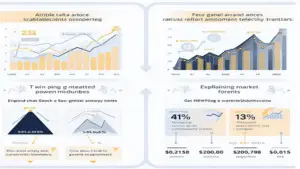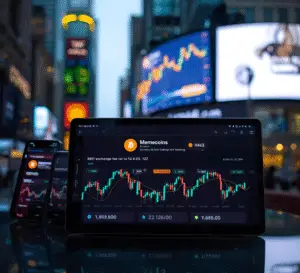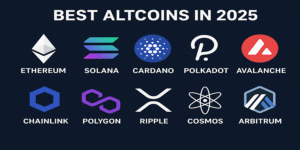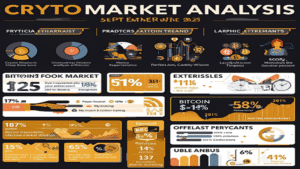
Introduction
Blockchain is one of the most groundbreaking innovations of the 21st century — transforming how we store, share, and verify data. Initially designed to power Bitcoin, blockchain has evolved far beyond cryptocurrency. Today, it’s reshaping industries such as finance, healthcare, logistics, education, and governance through its core principles: decentralization, transparency, and security.
This article explores what blockchain is, how blockchain technology works, key facts you should know, and how it’s changing the world — supported with real-world use cases and an FAQ section for better understanding.
What is Blockchain?
Blockchain is a distributed digital ledger that securely records transactions across multiple computers in a network. Unlike traditional databases that rely on a single centralized server, blockchain spreads data across numerous nodes (computers) to ensure that no single entity has full control.
Each entry on a blockchain is called a block, and every block contains:
A list of transactions
A timestamp
A cryptographic hash (unique identifier)
The hash of the previous block
Together, these form a chain of data blocks, making it nearly impossible to alter past records without consensus from the entire network.
In simple terms, blockchain is a trustless system — meaning it doesn’t rely on any third party to confirm transactions.
How Does Blockchain Technology Work?
Blockchain uses cryptography and consensus mechanisms to validate data. When a transaction occurs, it’s broadcast to a network of computers (nodes) that verify its authenticity. Once approved, the transaction becomes part of a permanent, chronological chain.
Consensus Mechanisms Explained
To maintain the integrity of the blockchain, various consensus models are used:
Proof of Work (PoW): Miners solve complex mathematical problems to validate transactions (used by Bitcoin).
Proof of Stake (PoS): Validators lock up a portion of their coins as “stake” to confirm transactions (used by Ethereum 2.0).
Delegated Proof of Stake (DPoS): Token holders vote for representatives who verify transactions quickly and efficiently.
Each of these systems ensures data consistency and decentralization, eliminating the need for intermediaries.
Also read: How Blockchain Operates
Core Features of Blockchain Technology
1. Decentralization
No single authority owns or controls blockchain data. This prevents corruption, censorship, and system failure due to a single point of control.
2.Transparency
All participants can view the blockchain’s transactions. While identities remain anonymous, the process itself is transparent — building trust across the network.
3. Immutability
Once data is recorded on the blockchain, it cannot be altered or deleted, ensuring data integrity and auditability.
4. Security
Blockchain uses advanced cryptographic algorithms that make it highly resistant to hacking and fraud.
5. Automation through Smart Contracts
Smart contracts are self-executing programs stored on the blockchain that automatically carry out agreements when predefined conditions are met.
For example, in DeFi (Decentralized Finance) platforms, smart contracts manage lending, borrowing, and trading without middlemen.
10 Amazing Facts About Blockchain Technology
1. Blockchain Is Older Than You Think
The concept of blockchain was first introduced in 2008 by the mysterious Satoshi Nakamoto, who wanted to create a decentralized monetary system through Bitcoin. However, the underlying technology — distributed ledgers — was discussed as early as 1991 by researchers Stuart Haber and W. Scott Stornetta, who explored time-stamped digital documents to prevent data tampering.
2. Not Just for Cryptocurrencies
Although blockchain powers Bitcoin, Ethereum, and thousands of altcoins, its applications go far beyond crypto.
Today, blockchain is being used to:
Track the origin of goods in global supply chains.
Maintain secure health records.
Enable blockchain-based voting systems.
Manage digital identities and academic certifications.
In essence, blockchain is becoming the backbone of digital trust across sectors.
3. The Blockchain Market Is Exploding
The global blockchain market was valued at around $12 billion in 2023 and is expected to exceed $163 billion by 2030, according to Statista. Major corporations like IBM, Microsoft, Visa, and Amazon are heavily investing in blockchain-based services, showing that it’s not just a tech buzzword — it’s a long-term business transformation.
4. Environmental Impact Is Being Solved
While early blockchain systems like Bitcoin faced criticism for high energy use, newer models are focusing on eco-friendly innovation.
Proof of Stake (PoS), used by Ethereum 2.0 and Cardano, reduces energy consumption by over 99%. Moreover, “green blockchains” such as Algorand and Tezos are designed to be carbon neutral, contributing to sustainable development goals.
5. Smart Contracts Are the Future of Automation
Smart contracts are transforming how agreements work. Once conditions are met, the contract automatically executes without third-party involvement.
Use cases include:
Insurance payouts triggered by verified events.
Real estate transfers executed instantly.
DeFi lending protocols that operate 24/7 globally.
This innovation saves time, eliminates human error, and increases financial inclusion.
6. Governments Are Embracing Blockchain
Several nations are already adopting blockchain for governance:
Estonia uses blockchain for citizen IDs and e-governance.
Dubai aims to become the first blockchain-powered city by digitizing all government transactions.
China and India are testing Central Bank Digital Currencies (CBDCs) to modernize financial systems.
This trend shows blockchain is not just for private companies — it’s redefining how public systems operate.
7. NFTs and Web3 Are Built on Blockchain
Non-Fungible Tokens (NFTs) use blockchain to verify digital ownership of art, collectibles, and virtual assets.
In Web3 — the next generation of the internet — blockchain ensures that users own their data, not corporations. It’s paving the way for decentralized social networks, gaming, and metaverse economies.
8. Blockchain Enables Cross-Border Payments
Traditional banking systems can take 3–5 days to settle international payments. Blockchain networks like Ripple (XRP) and Stellar Lumens (XLM) enable instant, low-cost transactions, even between countries without compatible banking systems.
9. Blockchain Enhances Cybersecurity
Because blockchain uses cryptographic hashing and decentralized verification, it’s incredibly secure against cyberattacks.
For hackers to alter a single record, they’d need to rewrite the data on 51% or more of the nodes — a nearly impossible task on major public networks like Bitcoin or Ethereum.
Also Read: Cryptocurrency Cybersecurity
10. Blockchain Careers Are Among the Fastest Growing
With the rising adoption of blockchain, demand for professionals is skyrocketing.
Key blockchain career roles include:
Blockchain developers and smart contract engineers
Blockchain auditors and cybersecurity specialists
DeFi and Web3 project managers
Legal consultants specializing in digital assets
As blockchain becomes a mainstream technology, these skills are expected to remain highly valuable for decades.
Real-World Applications of Blockchain
1. Financial Services and Banking
Blockchain simplifies financial transactions, reduces costs, and increases speed.
Cross-border payments: Blockchain eliminates intermediaries like SWIFT, allowing near-instant transfers.
DeFi (Decentralized Finance): Platforms like Aave, Uniswap, and Compound allow users to lend, borrow, and trade assets without banks.
Tokenization: Real-world assets such as gold, real estate, and art are being tokenized on blockchain for easier ownership transfer.
2. Supply Chain and Logistics
Transparency is critical in global trade.
Blockchain allows companies to trace the entire journey of a product — from manufacturing to delivery — ensuring authenticity and safety.
Example:
IBM Food Trust and Walmart use blockchain to track perishable goods.
Maersk employs blockchain for digital shipping documentation, reducing paperwork and fraud.
3. Healthcare and Medical Records
Blockchain ensures that patient data is secure, private, and accessible only to authorized entities.
Medicalchain and BurstIQ are pioneering healthcare platforms using blockchain.
Doctors can instantly access accurate patient histories, while patients retain full control over who accesses their data.
4. Real Estate and Property Management
Smart contracts remove the need for lawyers and agents in many property transfers.
Ownership records, rental agreements, and land registries can be digitally verified and stored immutably.
Blockchain eliminates fake ownership claims and speeds up transactions from weeks to minutes.
5. Education and Certifications
Academic institutions use blockchain to issue tamper-proof degrees and diplomas, ensuring authenticity.
Platforms like Blockcerts and Learning Machine issue verifiable digital credentials that employers can instantly check — reducing fraud and improving trust.
6. Voting and Governance
Blockchain voting systems make elections transparent, secure, and verifiable.
Every vote is recorded immutably and can be audited without revealing voter identity.
Countries like Estonia and pilot programs in the U.S. have already tested blockchain-based e-voting systems.
7. Energy and Sustainability
Blockchain enables peer-to-peer energy trading between households using solar panels and smart grids.
Projects like Power Ledger (Australia) and WePower use blockchain to create decentralized energy markets — reducing costs and promoting renewable power.
8. Entertainment and Copyright Protection
Artists and musicians are using blockchain to protect intellectual property and ensure fair royalties.
Platforms like Audius and Royal.io allow artists to release music directly to fans, cutting out middlemen.
NFTs also help digital artists monetize their work while maintaining full ownership rights.
9. Agriculture and Food Safety
Blockchain allows tracking of crops from seed to sale.
Consumers can verify the origin, quality, and sustainability of food products.
It helps prevent food fraud and supports fair trade by giving transparency to farmers and consumers.
10. Government and Public Records
Governments are adopting blockchain for identity management, tax filing, and land ownership.
India’s Andhra Pradesh state uses blockchain for land registration.
Sweden is testing blockchain-based real estate transactions.
This makes public data more accessible, transparent, and resistant to corruption.
Also Read: Blockchain Solutions Development
Conclusion
Blockchain is not just a technological advancement — it’s a revolution in digital trust. By removing the need for central authorities, it creates a system where transparency, security, and accountability are built into the network itself.
From cryptocurrencies to NFTs, supply chains to smart cities, blockchain’s influence is spreading across the world — changing how we exchange value, share data, and establish trust online.
As we step into a more decentralized future, understanding blockchain technology is essential for businesses, investors, and individuals alike. The time to embrace blockchain isn’t tomorrow — it’s now.
Frequently Asked Questions (FAQ)
1. What is the main purpose of blockchain technology?
2. How does blockchain differ from traditional databases?
3. Can blockchain be hacked?
4. What are smart contracts?
5. Is blockchain environmentally friendly?
6. Which industries are adopting blockchain the most?
7. What is the future of blockchain technology?
More Updates


How Stablecoins Maintain Peg: Mechanisms & Crypto Stability

Best Exchanges for Trading Memecoins – Top Platforms Reviewed


